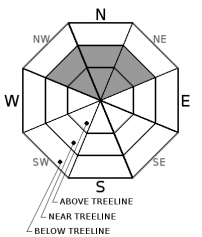| Saturday | Saturday Night | Sunday | |
|---|---|---|---|
| Weather: | Sunny skies. | Clear skies. | Sunny skies. |
| Temperatures: | 43 to 48 deg. F. | 26 to 32 deg. F. | 44 to 49 deg. F. |
| Mid Slope Winds: | Variable | Variable | Variable |
| Wind Speed: | Light winds | Light winds | Light winds |
| Expected snowfall: | 0 | 0 | 0 |
| Saturday | Saturday Night | Sunday | |
|---|---|---|---|
| Weather: | Sunny skies. | Clear skies. | Sunny skies. |
| Temperatures: | 41 to 46 deg. F. | 30 to 36 deg. F. | 43 to 48 deg. F. |
| Ridge Top Winds: | E | E | E |
| Wind Speed: | Light winds | Light winds becoming 10 to 15 mph with gusts to 25 mph after midnight. | Light winds becoming 10 to 15 mph with gusts to 25 mph in the afternoon. |
| Expected snowfall: | 0 | 0 | 0 |

























